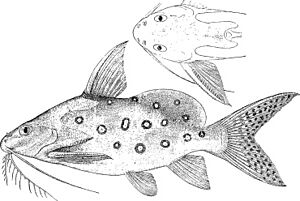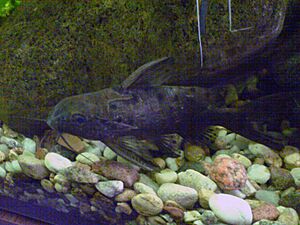Synodontis ocellifer facts for kids
Quick facts for kids Synodontis ocellifer |
|
|---|---|
 |
|
| Conservation status | |
| Scientific classification | |
| Genus: |
Synodontis
|
| Species: |
ocellifer
|
The ocellated synodontis (Synodontis ocellifer) is a cool type of upside-down catfish. It lives in rivers across northern and western Africa. You can find this fish in many countries. These include Burkina Faso, Cameroon, Chad, Gambia, Ghana, Guinea, Mali, Niger, Nigeria, and Senegal. A scientist named George Albert Boulenger first described it in 1900. He found it in Gambia. The name ocellifer means "eye-carrier" in Latin. This refers to the black spots on its sides. These spots sometimes have white centers.
Contents
What Does the Ocellated Synodontis Look Like?
Like other Synodontis fish, the ocellated synodontis has a strong, bony head. This head goes back to its first back fin spine. It also has a special bony part on its shoulder. This part is called a humeral process. Its shape helps scientists tell different species apart. For S. ocellifer, this part is long, narrow, and pointed.
This fish has three pairs of barbels. Barbels are like whiskers that help the fish feel and taste. One pair is on its upper jaw. Two pairs are on its lower jaw. The upper jaw barbels are straight. They have a thin skin flap at their base. They are about one and a half times the length of its head. The outer pair of lower jaw barbels is twice as long as the inner pair. Both lower jaw barbels have long, thin branches.
The front edges of the back fin and side fins are stiff spines. The back fin spine is a bit shorter than the head. It is smooth on the front and rough on the back. The rest of the back fin has seven soft rays. The side fin spine is about as long as the head. It is rough on both sides. The small, fleshy fin near the tail is called the adipose fin. It is four to five times longer than it is deep. The fin on its belly has four unbranched rays and seven or eight branched rays. Its tail fin is deeply split, like a fork. The upper part of the tail is longer than the lower part.
All Synodontis fish have a special pad of teeth on their upper jaw. This is called a premaxillary toothpad. It has several rows of short, chisel-shaped teeth. In S. ocellifer, this toothpad is short and wide. On its lower jaw, the teeth are attached to flexible stalks. They are shaped like an "S" or a hook. The number of these teeth helps identify the species. The ocellated synodontis has 20 to 30 teeth on its lower jaw.
The body of this fish is grey-brown on its back and sides. Its belly is white. It has large black and white spots on its body and adipose fin. These spots can be solid black or black rings with white centers.
This fish can grow up to about 49 centimeters (19 inches) long. Female Synodontis fish are usually a bit bigger than males of the same age.
Home and Habits of the Ocellated Synodontis
In the wild, you can find the ocellated synodontis in several river systems. These include the Chad River, Niger River, Volta River, Senegal River, and Gambia River.
Reproduction and Life Cycle
Scientists do not know much about how most Synodontis species reproduce. We know that females can carry many eggs. They likely lay their eggs during the rainy season. This is usually between July and October. During this time, pairs of fish may swim together to lay eggs.
What Do They Eat?
Synodontis fish are omnivores. This means they eat both plants and animals. They eat things like insect larvae, algae, snails, clams, sponges, and small crustaceans. They also eat the eggs of other fish. They grow quickly in their first year. After that, their growth slows down as they get older.



